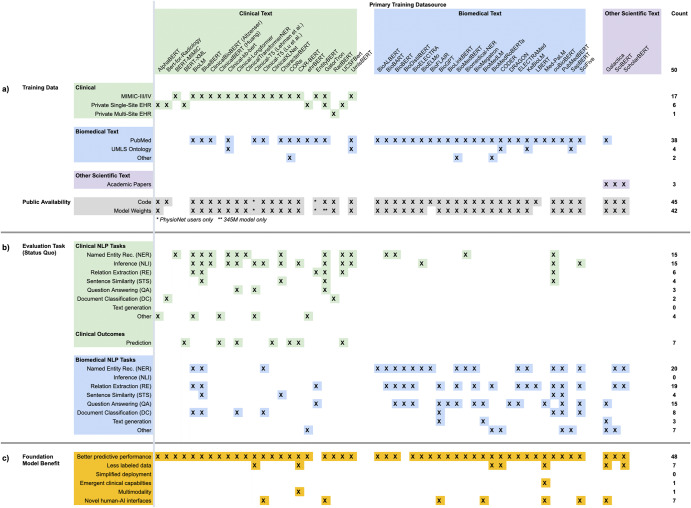Fig. 2. Overview of CLaMs.
A summary of CLaMs and how they were trained, evaluated, and published. Each column is a specific CLaM, grouped by the primary type of data they were trained on. Columnwise, the CLaMs primarily trained on clinical text are green (n = 23), those trained primarily on biomedical text are blue (n = 24), and models trained on general academic text are purple (n = 3). The last column is the count of entries in each row. An X indicates that the model has that characteristic. An * indicates that a model partially has that characteristic. a Training data and public availability of each model. The top rows mark whether a CLaM was trained on a specific dataset, while the bottom-most row records whether a model’s code and weights have been published. Almost all CLaMs have had their model weights published, typically via shared repositories like the HuggingFace Model Hub. b Evaluation tasks on which each model was evaluated in its original paper. Green rows are tasks whose data were sourced from clinical text and blue rows are evaluation tasks sourced from biomedical text. The tasks are presented by the way they are commonly organized in the literature. CLaMs primarily trained on clinical text are evaluated on tasks drawn from clinical datasets, while CLaMs primarily trained on biomedical text are almost exclusively evaluated on tasks that contain general biomedical text (i.e., not clinical text). c Clinical FM benefits on which each model was evaluated in its original paper. The underlying tasks presented in this section are identical to those in (b), but here the tasks are reorganized into six buckets that reflect the six primary FM benefits described in Benefits of clinical FMs. While almost all CLaMs have demonstrated the ability to improve predictive accuracy over traditional ML approaches, there is scant evidence for the other five value propositions of clinical FMs.

